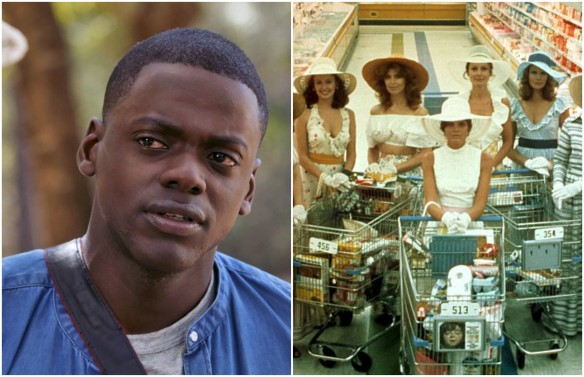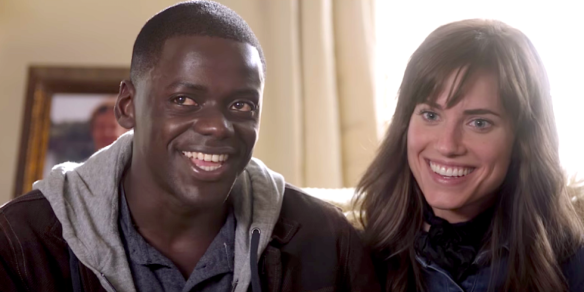
Brainwashing, body snatching, experimental procedures, what have you, there’s a lot to fear from the power of affluent white people. That may sound crazy but science fiction ulterior motives are almost more comforting to believe in than a grand evil scheme concocted by white upper class than age-old racism and sexism. Get Out has made a huge splash as being one of the most woke horror movies ever made. It brings the subtext of oppression and otherness that past genre films have alluded to and made it literal text. The story of a black man Chris (Daniel Kaluyaa) going on a weekend vacation to visit his white girlfriend’s parents devolves into a conspiracy of modern day slavery and exaggerated cultural appropriation. Sure it is a heightened scenario of a white community luring black people to be used as body surrogates since they are superior physical, artistic and intellectual beings but there are many other smaller interactions that director Jordan Peele tackles of modern day racism such as a black man being followed by a car in the suburbs or the excessive need for the white people Chris meets in this upstate neighborhood to prove they’re not racist by stating how much they like Tiger Woods. Get Out couldn’t have come at a more opportune time for America where the conversation on race has come to the forefront. Now being a white person, I’m not the right person to talk about the importance of Get Out or the black experience in any way but Peele has expressed that his inspiration for the movie came from 1975’s The Stepford Wives, that premise being a similar affluent suburb of Connecticut has men turning their wives into subservient robots. The female experience being something I’m more familiar with, I decided to double feature the 70’s horror film as well as it’s 2004 comedy remake to see where Peele drew his influence and how I can tangentially talk about Get Out.
I’m first inclined to believe that Peele derived from both incarnations of Ira Levin’s novel. Obviously tonally he’s going for the thriller elements of the 1975 Wives which was also a slow burn build up as Joanna (Katharine Ross) and her husband Walter (Peter Masterson) move to the town of Stepford from the big city and during her four months stay, she notices the abnormal perfections that are the women of the prim and proper suburb. Yet Frank Oz’s Stepford Wives is a richer satire as well as being a broad comedy which has some time to shine in Get Out which supporting actor LilRel Howery brings in the third act. The thesis statement in those films is that the modern woman is becoming too independent and free-thinking so their boilerplate, vanilla husbands invent a way to replace their partners with identical looking fembots whose only desire is to please whether that be sexual or dedicating their time to a clean house and home cooked meals. This obviously derives from the 50’s idyllic homemaker which is more pronounced in the remake. Not subtly shown in the opening credits montage are vintage household appliance commercials being modeled by ecstatic women then once actually in the town, everyone is made up in the dresses and hair dos presented in the aforementioned ads. The real biting satire comes from the fact that all the transformed Stepford wives were career women, CEOs and novelists whose husbands were left inferior and therefore compelled to “upgrade” their women into big breasted cyborgs. The motivations in the ’75 version are much less warranted where our lead Joanna is not the creative director for a television network but a stay at home mom with a budding photography interesting. The fact that her schlub of a lawyer husband Walter feels the need to change her because they sometimes argue is way more disturbing.
Stepford Wives is examining the gender gap of “boys will be boys” and “women belong in the kitchen” stereotypes which in Get Out translates to the gap between the long-standing racial divide in America. Both have a storied history in these McMansion neighborhoods. Peele is examining how going back to slavery, blacks were viewed as either the help, seen at the Armitage estate with the housekeeper Georgina (Betty Gabriel) and Walter (Marcus Henderson) or as sexual beings like former Brooklynite Andre (Keith Stanfield) standing as arm candy for a much older woman. Chris and Joanna are witnessing these reductive molds being forced on their peers and know that no one does this willingly. Just as Joanna sees her slobbish, eccentric friend Bobbie (Paula Prentiss and Bette Midler respectively) transform into trophy wives, Chris similarly sees the phony exterior of Andre and the haywire mechanism triggered by either a camera flash or slight trauma proves that their humanity is somehow vacant. All films are tales of humans using advanced technology to simplify one’s identity, the funniest instance is that of in ’75’s Wives it’s an ex-Disney Imagineer who is the proprietor of the Mr. Lincoln-esque fembots. It’s the paradox of no matter how far we improve in science and technology, there’s the need to hold on or revert to the past, in this situation the oppressive former ways of life.





